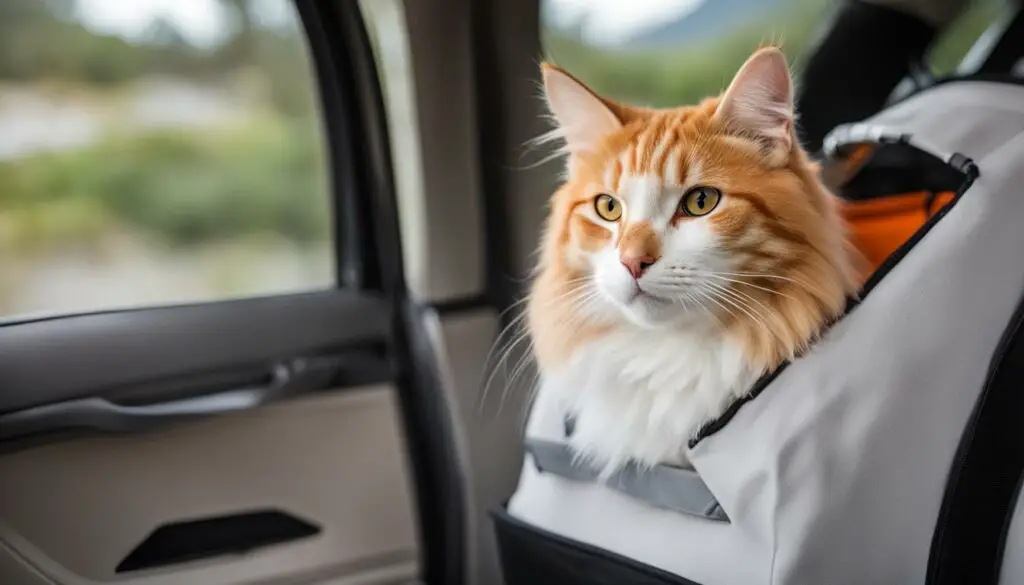Transporting a cat in a car can be a challenging task for many pet owners. Cats often have negative associations with car rides due to trips to the vet or the anxiety caused by the motion and unfamiliar environment. However, with the right training and preparation, cats can learn to enjoy car rides and travel more comfortably. In this article, I will share expert tips on how to transport your cat in a car with ease and create a positive experience for both you and your feline friend.
Transporting your cat in a car doesn’t have to be stressful. By following these expert tips, you can make car travel a more enjoyable experience for your cat:
- Introduce the carrier as a positive and familiar space
- Gradually acclimate your cat to short car rides
- Use calming techniques to reduce anxiety
- Plan regular stops and pack essential items for your cat’s comfort
- Ensure safety and comfort during the journey
Key Takeaways:
- Training and positive associations can help cats enjoy car rides
- The carrier should be a cozy and familiar space for the cat
- Calming techniques such as familiar scents and soothing music can help reduce anxiety
- Gradually introduce your cat to car rides to build positive associations
- Ensure safety and comfort by using a secure carrier and packing essential items
Understanding a Cat’s Aversion to Car Travel
Many cats have a strong aversion to car travel, stemming from negative associations with trips to the vet and the overwhelming sensory experience of being in a moving vehicle. Understanding the reasons behind their aversion can help us find ways to make car travel more comfortable and less stressful for our feline friends.
One of the main reasons cats dislike car rides is the association with vet visits. Cats often have negative experiences at the vet, such as vaccinations or uncomfortable procedures, which can make them anxious about getting into a car. Additionally, the unfamiliar sights, sounds, and smells of the car environment can be overwhelming for cats, who are creatures of habit and prefer familiar surroundings.
To address a cat’s aversion to car travel, it’s important to gradually introduce them to the car and the carrier in a positive and gentle way. By creating a calm and familiar environment for the cat inside the carrier, using treats and rewards to encourage them to spend time in it, and gradually increasing the duration of car rides, we can help them develop a more positive association with car travel.

Understanding and addressing a cat’s aversion to car travel is crucial for ensuring their comfort and safety during journeys. By taking the time to desensitize them to the car environment and create positive associations, we can help make traveling with our feline companions a more enjoyable experience for everyone involved.
Creating a Positive Association with the Carrier
When it comes to car travel, the carrier is often a significant source of anxiety for cats. To help alleviate their stress and create a positive association, it’s crucial to make the carrier a cozy and familiar space for them. Consider leaving the carrier out as part of their everyday environment, placing their favorite blanket inside, and rewarding them with treats and playtime when they willingly enter the carrier. By doing so, you can help them feel more comfortable and at ease.
Gradually increasing the amount of time the cat spends inside the carrier with the door closed can also be beneficial. Start with short intervals and gradually lengthen the duration while ensuring the cat remains calm and relaxed. This step-by-step approach allows the cat to become acclimated to the carrier and associate it with positive experiences, making it less intimidating.
Introducing the cat to short car rides is another important step in creating a positive association with the carrier. Start with brief trips around the neighborhood, gradually increasing the distance and duration. Reward the cat with treats and praise after each successful car ride. This way, the cat will begin to associate the carrier with enjoyable experiences and be more receptive to car travel in the future.
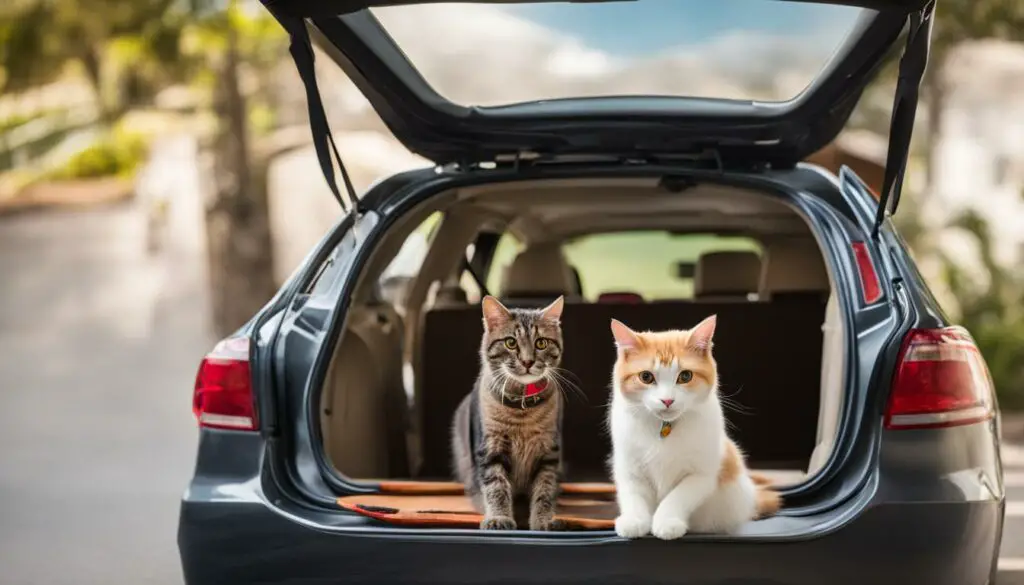
Creating a positive association with the carrier is essential for a successful car travel experience with your cat. By making the carrier a comfortable and familiar space, gradually introducing the cat to it, and rewarding them for positive behavior, you can help alleviate their anxiety and make car travel a more enjoyable experience for both you and your feline friend.
Calming Techniques for Safe Cat Car Travel
Transporting a cat in a car can be a stressful experience for both the cat and the owner. However, there are several calming techniques that can help create a more soothing and relaxed environment during car travel. These techniques can help reduce anxiety and make the journey safer and more comfortable for your feline companion.
Creating a Calm Atmosphere
One effective calming technique is to create a calm atmosphere in the car. You can achieve this by using familiar scents that your cat finds comforting. Consider placing a blanket or bedding with their scent inside the carrier to provide a sense of familiarity and security. Additionally, playing calming music specifically designed for cats can provide a soothing background noise that can help reduce anxiety.
Using Calming Pheromones
Calming pheromone sprays or diffusers can also be helpful in reducing your cat’s stress levels during car travel. These products contain synthetic pheromones that mimic the natural pheromones released by cats when they feel safe and secure. By using these products in the car, you can create a sense of security for your cat, making them feel more at ease.
It’s important to note that while these calming techniques can be effective for many cats, every cat is unique, and what works for one may not work for another. If your cat experiences severe anxiety during car travel, it may be beneficial to consult with a veterinarian who can provide additional guidance and potentially recommend medications that can help calm your cat during car rides.
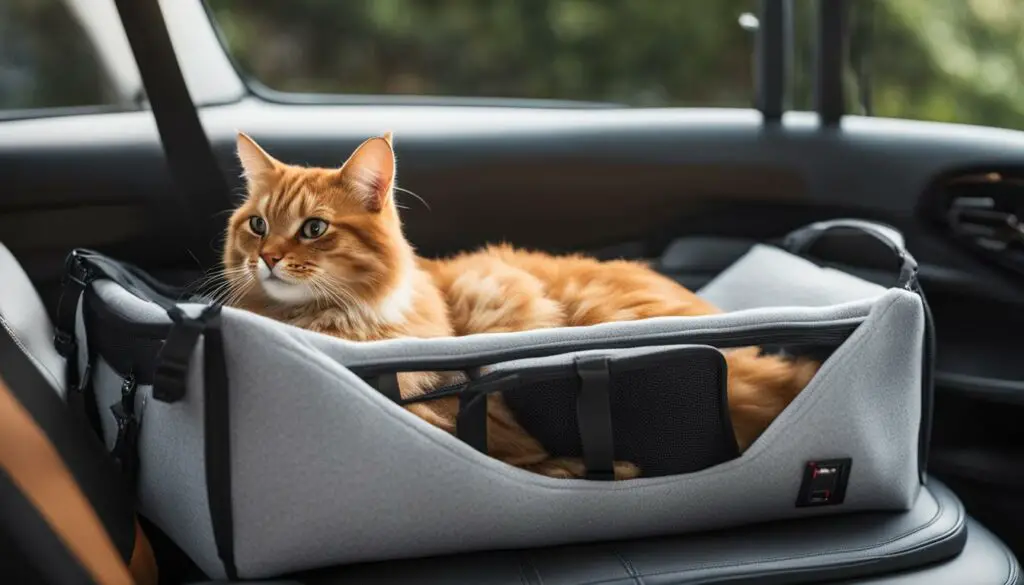
| Calming Technique | Description |
|---|---|
| Familiar Scents | Placing a blanket or bedding with your cat’s scent inside the carrier to create a sense of familiarity and security. |
| Calming Music | Playing calming music specifically designed for cats to provide a soothing background noise that helps reduce anxiety. |
| Calming Pheromones | Using pheromone sprays or diffusers that mimic the natural pheromones released by cats to create a sense of security and calmness. |
Tips for Traveling with a Cat in a Car: Ensuring Safe and Comfortable Journeys
Traveling with a cat in a car can be a rewarding experience with the right preparation and precautions. To ensure a safe and comfortable journey for both you and your feline friend, here are some essential tips to consider:
Create a Comfortable Space
Before starting the car ride, make sure your cat is comfortable and secure in their carrier. Line the carrier with soft bedding and familiar scents to create a cozy environment. Additionally, ensure that the carrier is properly secured in the car to prevent any movement or potential accidents during the journey.
Plan Regular Breaks
During long car rides, it’s important to plan regular breaks to allow your cat to stretch their legs, use the litter box, and drink water. Find pet-friendly rest stops along your route and provide a safe and enclosed area for your cat to explore. This will help reduce any anxiety or restlessness and make the journey more enjoyable for your furry companion.
Use Calming Techniques
If your cat experiences anxiety or stress during car travel, consider using calming techniques to help them relax. Some options include playing soothing music or using a pheromone spray designed to reduce stress in cats. Consult with your veterinarian for additional advice or recommendations based on your cat’s specific needs.
| Traveling with a Cat in a Car: Tips for a Safe and Comfortable Journey |
|---|
| 1. Create a comfortable and secure space in the carrier. |
| 2. Plan regular breaks for your cat to stretch and use the litter box. |
| 3. Use calming techniques such as soothing music or pheromone sprays. |
By implementing these tips, you can ensure that your cat’s car travel experience is as stress-free and enjoyable as possible. Remember to always prioritize their safety and comfort throughout the journey, and consult with your veterinarian for personalized advice.

Ensuring Safety and Comfort During Car Travel
When transporting a cat in a car, it is essential to prioritize their safety and comfort. By following a few key guidelines, you can make the journey more enjoyable for your feline friend.
Using a Secure Carrier
First and foremost, it is recommended to use a carrier to transport your cat in the car. This not only keeps them secure but also prevents any potential accidents or injuries. Ensure that the carrier is secured properly, allowing your cat to stand, sit, and reposition comfortably. A carrier with a sturdy construction and proper ventilation is ideal for long journeys.
Packing Essential Items
Remember to pack essential items to keep your cat comfortable during the journey. These items may include food, water, toys, and a portable litter box. Having familiar items from home can help reduce anxiety and provide a sense of security for your cat.
Securing the Car
It’s important to secure the car to ensure that your cat remains safe during the travel. Using a car seat cover can help protect your vehicle from any accidents or messes. Additionally, for adventurous cats, consider using a harness with a seatbelt loop to provide added security. This will help prevent your cat from roaming freely in the car and potentially causing distractions.
| Essentials | Benefits |
|---|---|
| Food | Ensure your cat has access to their regular diet during the journey to maintain their health and well-being. |
| Water | Staying hydrated is crucial for your cat’s comfort and overall health during the travel. Bring enough water for the duration of the journey. |
| Toys | Keeping your cat entertained with familiar toys can help reduce stress and anxiety, making the journey more enjoyable for them. |
| Portable Litter Box | Providing a portable litter box ensures that your cat has a designated area for elimination, promoting their comfort and well-being. |
Ensuring safety and comfort during car travel is crucial for a stress-free journey with your cat. By using a secure carrier, packing essential items, and securing the car, you can create a safe and comfortable environment for your feline companion. Taking these precautions will help make the travel experience enjoyable and worry-free for both you and your cat.
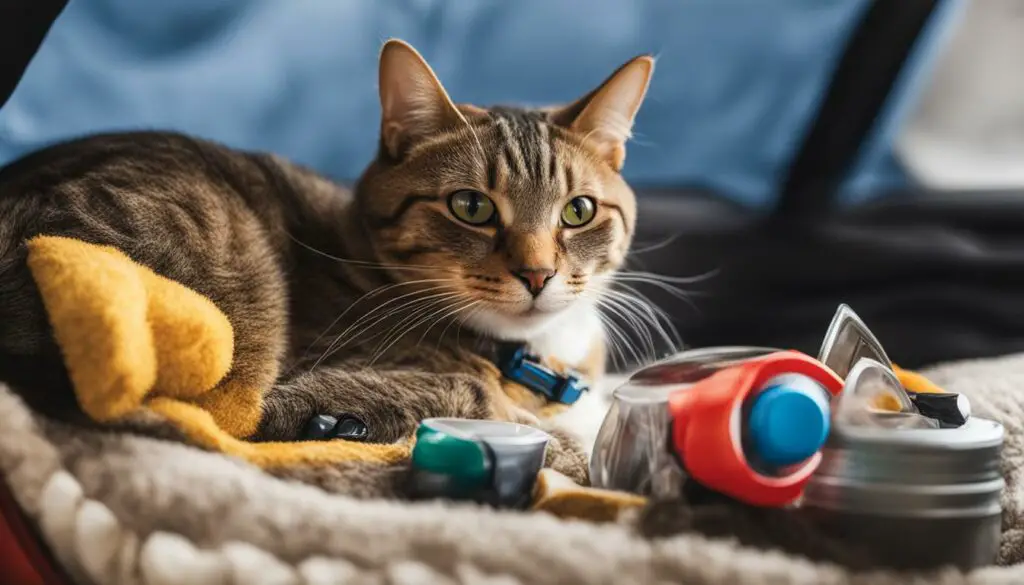
Planning for Long Car Rides
When embarking on a long car ride with your cat, careful planning is essential to ensure a safe and comfortable journey. By following a few key steps, you can make the experience much smoother for both you and your feline companion.
1. Gradual Introduction: Before embarking on a long journey, it’s important to gradually introduce your cat to car rides. Start with short trips around the neighborhood and gradually increase the duration of the rides. This will help your cat become more accustomed to the car and reduce anxiety.
2. Regular Stops: Plan regular stops along your route to allow your cat to stretch their legs, use the litter box, and have a drink of water. These breaks are essential for your cat’s comfort and well-being during the journey.
3. Cat-Friendly Accommodations: When planning your itinerary, make sure to choose accommodations that are cat-friendly. Look for hotels that allow pets and have amenities such as litter boxes and scratching posts. This will ensure that your cat feels comfortable and secure throughout the trip.
Tips for Moving with Cats
Moving to a new home can be a stressful experience for cats. However, with careful preparation and consideration, you can make the transition smoother for your feline friend. Here are some helpful tips for moving with cats:
Create a Cozy Space
Before moving day, set up a cozy space in the new home for your cat. Include familiar items like their bed, toys, and a litter box. This will help them feel secure and comfortable in their new environment.
Introduce a Crate
If your cat isn’t already comfortable with a crate, gradually introduce them to it before the move. Use positive reinforcement to help them associate the crate with positive experiences. This will provide a safe space for them during the move and reduce anxiety.
| Tip | Details |
|---|---|
| Take Short Car Rides | Prior to the actual move, take your cat on short car rides to help them get used to the motion and associate the car with positive experiences. |
| Leash Training | If your cat is comfortable on a leash, consider using it during stops along the way to keep them safe and prevent them from wandering off. |
| Update Identification | Make sure to update your cat’s tags or microchip with the new address in case they accidentally wander off during the move. |
“By following these tips, you can help reduce stress and ensure a smoother moving experience for both you and your feline companion.”
Remember, every cat is unique and may react differently to a move. Take your cat’s individual personality and needs into account when planning and executing the move. With patience, understanding, and some extra TLC, you can help your cat feel at home in their new surroundings.
Keeping Your Cat Comfortable During the Move
When it comes to traveling with your cat, ensuring their comfort during the move is essential. By taking the necessary precautions and providing a safe and secure environment, you can help reduce your cat’s stress and make the journey more enjoyable for both of you.
To keep your cat comfortable, it is recommended to use a pet restraint, such as a hard-shelled crate, in the car. This will not only prevent your cat from becoming a projectile in case of an accident but also provide them with a familiar and secure space during the trip. Make sure the carrier is properly secured and allows your cat to stand up and reposition comfortably.
Additionally, pack essential items for your cat’s comfort during the journey. This includes food, water, toys, and a portable litter box. Having these items easily accessible in the car will help keep your cat calm and content throughout the move. Remember to plan for regular rest stops to allow your cat to stretch their legs, use the litter box, and stay hydrated.
“By taking the necessary precautions and providing a safe and secure environment, you can help reduce your cat’s stress and make the journey more enjoyable for both of you.”
Lastly, consider choosing cat-friendly accommodations along the way. This could include pet-friendly hotels or staying with friends or family who are comfortable with having a cat in their home. By ensuring your cat has a comfortable and familiar space to rest during the trip, you can help alleviate their anxiety and make the journey a positive experience.
Remember, the key to keeping your cat comfortable during the move is to prioritize their safety, provide them with a secure space, and pack essential items for their well-being. By following these steps, you can help ensure a stress-free and enjoyable journey for your cat.
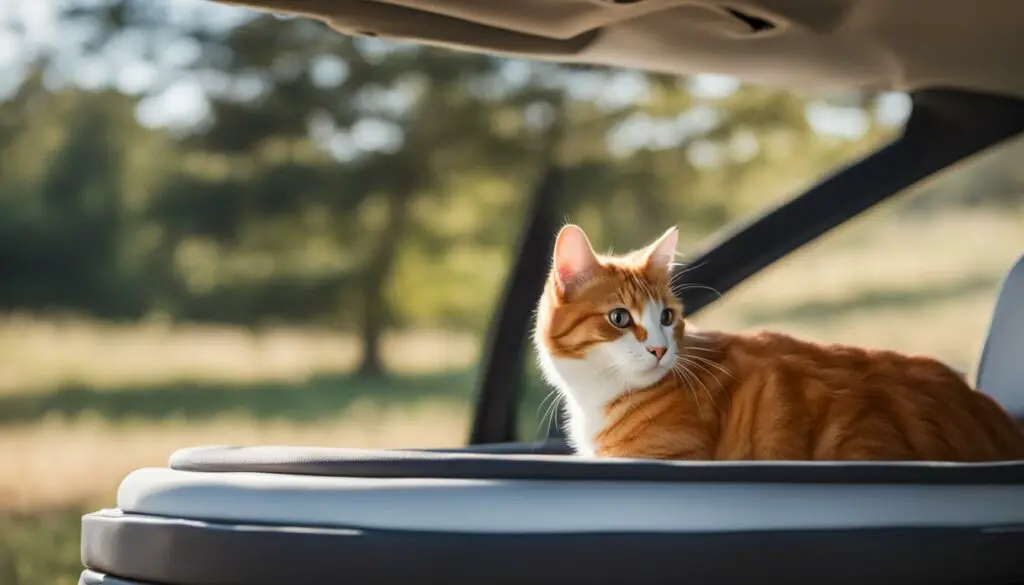
Helping Your Cat Adjust to a New Home
After a long journey, it’s time to help your cat adjust to their new home. Creating a familiar and secure space for them is essential in easing the transition. Set up a cozy area with their bed, toys, and a litter box, making sure it’s in a quiet location where they can retreat to for comfort. Introduce the cat to one room at a time, gradually expanding their access to the rest of the house. This will help prevent them from feeling overwhelmed and allow them to establish a sense of territory.
During the first few weeks, it’s recommended to keep the cat indoors. This will allow them to become familiar with the new surroundings and prevent them from trying to return to their previous home. Supervised outdoor visits or tethered time in the yard can gradually be introduced once they have settled in. Always make sure to update the cat’s identification tags or microchip with the new address to ensure their safety.

Essential Considerations for Moving with Cats
Moving with cats requires careful planning and preparation to ensure a smooth and stress-free experience. Here are some essential considerations to keep in mind:
Cat-Friendly Carriers
Invest in a sturdy and secure carrier that provides enough space for your cat to stand, turn around, and lie down comfortably. Make sure the carrier is well-ventilated and has a secure locking mechanism to prevent any escapes during transit. Place a familiar blanket or bedding inside the carrier to create a cozy and comforting environment for your cat.
Secure Restraints
When transporting your cat in a car, it’s crucial to prioritize their safety. Use a seatbelt or a specifically designed harness with a seatbelt attachment to secure the carrier in place. This prevents the carrier from sliding or tipping over during sudden stops or turns. Avoid letting your cat roam freely in the car, as this can be dangerous and distracting for both you and your feline companion.
Familiar Surroundings
During the move, try to maintain a sense of familiarity for your cat. Pack their favorite toys, blankets, and litter box so that they have familiar scents and objects in the new environment. This will help ease their anxiety and promote a smoother transition. Set up a designated space in the new home with these familiar items to create a safe and comforting haven for your cat.
Regular Breaks and Feline-Friendly Accommodations
Plan regular stops during your journey to allow your cat to stretch their legs, use the litter box, and hydrate. Research and book accommodations in advance that are cat-friendly and offer a safe and comfortable environment for your furry friend. This includes ensuring there are no potential hazards or toxic plants in the vicinity.
| Essential Considerations for Moving with Cats |
|---|
| Cat-Friendly Carriers |
| Secure Restraints |
| Familiar Surroundings |
| Regular Breaks and Feline-Friendly Accommodations |
By taking these essential considerations into account, you can minimize stress and ensure the safety and well-being of your cat during the moving process. Remember to stay patient and provide plenty of reassurance and love to help your feline companion adjust to their new surroundings.
Addressing Specific Concerns during Car Travel
When it comes to transporting a cat in a car, it’s important to address specific concerns to ensure a more comfortable journey for your feline friend. Cats can experience motion sickness or anxiety during car rides, which can make the experience stressful for both the cat and the owner. To alleviate these concerns, there are a few steps you can take.
- Consult with a veterinarian: If your cat is prone to motion sickness or severe anxiety, it may be beneficial to consult with a veterinarian. They can provide guidance on appropriate medications or supplements that can help calm your cat during car rides.
- Use calming techniques: Introduce familiar scents, play soothing music, or use pheromone sprays designed for cats to create a calming environment in the car. These techniques can help reduce anxiety and promote a sense of security for your cat.
- Plan for regular breaks: Cats have unique needs, including the need for regular water and elimination breaks. It’s essential to plan for these breaks during long car rides to ensure your cat stays comfortable and healthy throughout the journey.
- Choose cat-friendly accommodations: When planning your trip, make sure to choose accommodations that are cat-friendly. Look for hotels or rental properties that provide amenities for cats, such as scratching posts or litter boxes, to help your cat feel more at home.
By addressing these specific concerns, you can help create a safer and more comfortable car travel experience for your cat. Remember to consult with a veterinarian for personalized advice and to ensure your cat’s well-being during the journey.
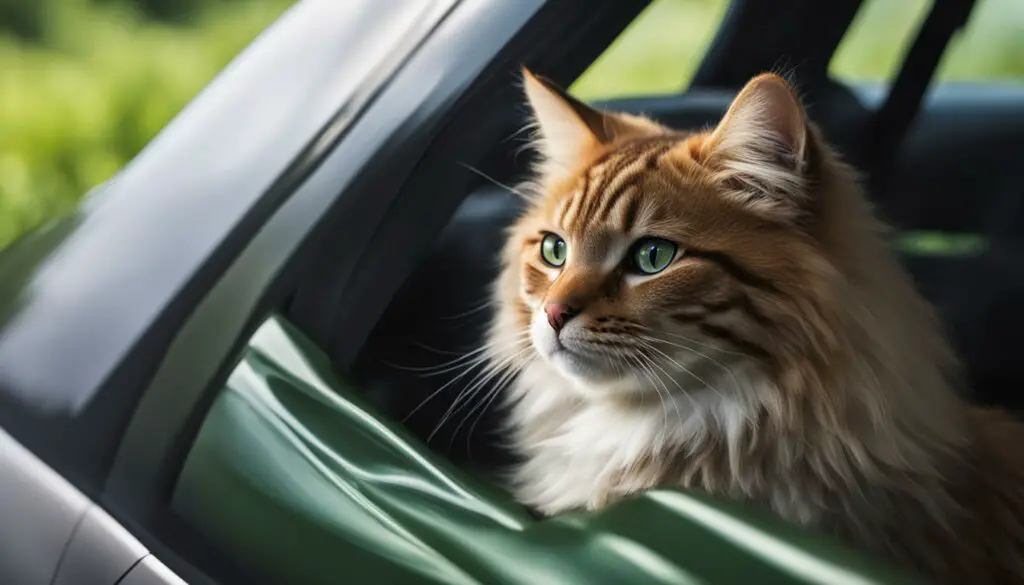
Consult with a veterinarian for personalized advice and to ensure your cat’s well-being during the journey.
Tips for Traveling with a Cat in a Car: Creating a Cat-Friendly Car Travel Experience
When it comes to traveling with your feline friend, it’s important to create a cat-friendly car travel experience to ensure their comfort and safety. By following these expert tips, you can make your next car journey with your cat a stress-free and enjoyable adventure.
1. Desensitization and Positive Reinforcement
Before embarking on a car trip with your cat, it’s essential to desensitize them to the car and the carrier. Start by leaving the carrier out as part of their familiar environment and reward them with treats and playtime when they voluntarily enter the carrier. Gradually increase the amount of time spent in the carrier and introduce short car rides, rewarding positive behavior with praise and treats. This gradual approach helps create a positive association with the carrier and car, reducing anxiety during travel.
Remember to use high-value rewards and incorporate playtime during car rides to keep your cat engaged and entertained. This positive reinforcement helps them associate car rides with positive experiences, making future journeys more comfortable for both of you.
2. Creating a Cozy and Familiar Travel Environment
To ensure your cat’s comfort during car travel, create a cozy and familiar environment inside the carrier. Place their favorite blanket or bedding inside to provide a sense of security and familiarity. You can also add a piece of clothing with your scent to further comfort them during the journey.
Additionally, consider using familiar scents in the car, such as a calming pheromone spray or a lavender sachet, to help reduce anxiety. Playing soothing music designed for cats can also create a calming ambiance in the car. These small comforts can go a long way in making your cat feel more at ease during the journey.
3. Essential Supplies for a Smooth Travel Experience
When traveling with your cat in a car, it’s crucial to pack essential supplies to ensure their comfort and well-being. These supplies may include:
- A sufficient supply of food and water for the duration of the journey
- A portable litter box and litter to provide a familiar and accessible toileting area
- Favorite toys or comfort items to keep your cat entertained and provide a sense of familiarity
- A leash and harness for safety during stops or outdoor breaks
- Any necessary medications or medical records, in case of emergencies
By being well-prepared with these supplies, you can ensure that your cat remains comfortable, happy, and healthy throughout the car journey.

Remember, every cat is unique, and it’s important to cater to their individual needs and preferences during car travel. By implementing these tips and tricks, you can create a cat-friendly car travel experience that allows you and your feline companion to enjoy the journey together.
Ensuring Safety and Comfort on Long Car Rides
When embarking on a long car journey with your cat, it is essential to prioritize their safety and comfort. By taking the necessary precautions, you can ensure a smooth and stress-free travel experience for both you and your feline companion.
Prioritize a Secure Carrier
Choosing the right carrier is crucial for the well-being of your cat during car travel. Opt for a carrier that is both secure and spacious enough for your cat to stand and reposition comfortably. This will prevent your cat from getting injured in case of any sudden stops or accidents. If your cat tends to be more adventurous, consider using a harness with a seatbelt loop to provide an extra layer of security.
Hygiene and Cleanliness
Maintaining a clean and hygienic car is important for your cat’s comfort during the journey. Use a car seat cover to protect your car from pet hair and to make cleaning easier. This will help create a more pleasant environment for your cat and reduce any potential allergies or irritations. Additionally, pack cleaning supplies such as pet-safe wipes or a portable vacuum cleaner to address any messes or accidents that may occur along the way.
Consult with Your Veterinarian
If your cat tends to experience motion sickness or anxiety during car rides, it is advisable to consult with your veterinarian. They can provide guidance and recommend appropriate medications or natural remedies to help calm your cat and make the journey more comfortable for them. Your veterinarian will also be able to address any specific concerns you may have and provide personalized advice based on your cat’s individual needs.
| Key Steps for Safe Car Travel with Cats |
|---|
| Choose a secure and spacious carrier |
| Use a car seat cover for cleanliness |
| Consult with your veterinarian for advice |
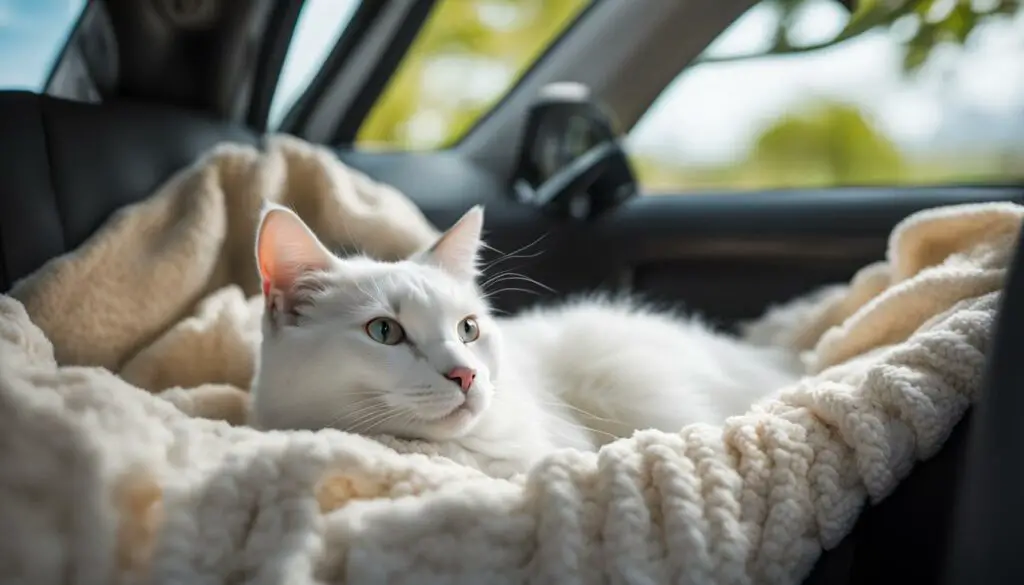
Making your cat’s comfort and safety a priority during long car rides is essential. By providing a secure carrier, maintaining cleanliness within the car, and consulting with your veterinarian if necessary, you can create a safe and enjoyable travel experience for your feline friend.
Planning for a Smooth Journey with Your Cat
Traveling with a cat in a car can be a daunting task, but with careful planning and preparation, you can ensure a smooth journey for both you and your feline friend. Here are some essential tips for traveling with a cat in a car:
- Create a Cat-Friendly Environment: Before the journey, make sure the cat is comfortable and familiar with the carrier. Leave it out in their living space and make it cozy by adding their favorite blanket or toys. Encourage them to enter the carrier voluntarily and reward them with treats and playtime inside.
- Gradual Introduction to Car Rides: Start by taking short drives around the neighborhood to acclimate your cat to the motion and sounds of the car. Increase the duration of the trips gradually, ensuring that your cat remains calm and relaxed throughout.
- Address Specific Concerns: If your cat experiences anxiety or motion sickness during car rides, consult with your veterinarian for appropriate medications or natural remedies. Using calming techniques such as familiar scents, soothing music, and pheromone sprays can also help reduce stress.
- Plan Regular Stops: Cats need regular breaks for water, food, and bathroom breaks. Plan your travel route with cat-friendly rest areas where your furry friend can stretch their legs and use a portable litter box.
By following these tips, you can ensure a safe, comfortable, and stress-free journey for your cat during car travel. Remember to be patient and understanding, as every cat has their own unique preferences and needs. With proper planning and preparation, you and your cat can enjoy many adventures together on the road.
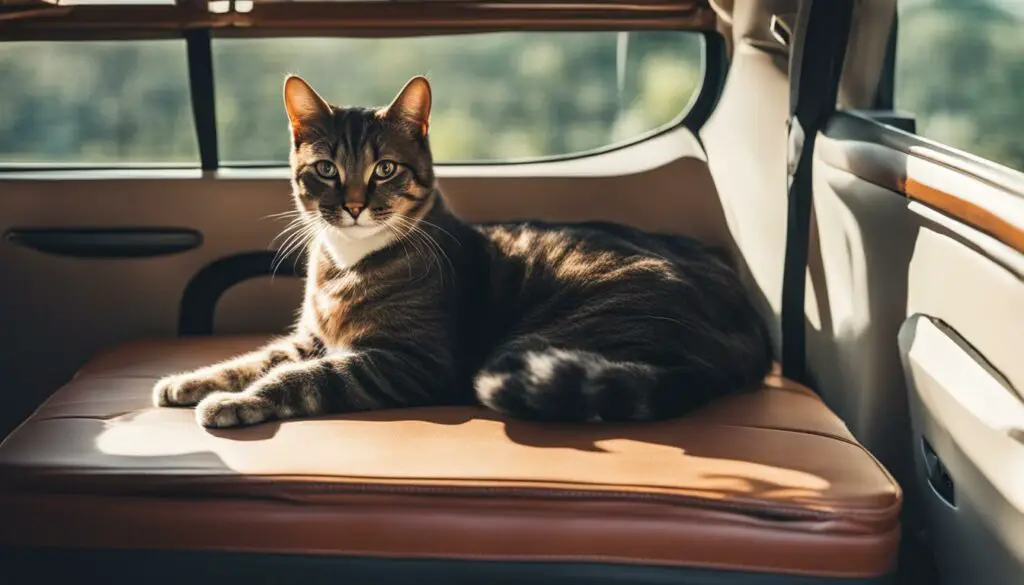
“Traveling with a cat requires careful planning and preparation. By creating a cat-friendly environment, gradually introducing car rides, addressing specific concerns, and planning regular stops, you can ensure a smooth journey for your feline friend.” – Me, a Cat Travel Expert
Now that you have learned how to plan for a smooth journey with your cat, let’s move on to the next section, where we will discuss the importance of desensitization and positive reinforcement when it comes to traveling with cats in a car.
Conclusion
Transporting a cat in a car can be a stress-free endeavor with the right preparation and training. By creating positive associations with the carrier and the car, gradually introducing the cat to car rides, and addressing specific concerns such as anxiety, you can help alleviate stress and make the journey safer and more comfortable for your feline friend.
Remember to plan regular stops for water and elimination breaks during long car rides, and choose cat-friendly accommodations along the way to ensure a smooth travel experience. By following these expert tips, you can make car travel with your cat a more enjoyable experience for both of you.
Whether you’re taking a short trip or embarking on a long-distance move, these strategies will help your cat feel more at ease and make the journey as comfortable as possible. With a little patience, positive reinforcement, and attention to your cat’s needs, you can transform car travel from a stressful experience to a pleasant one for both you and your furry companion.
FAQ
Why do cats dislike traveling in cars?
Cats often associate car rides with trips to the vet and can feel overwhelmed by the motion and new environment.
How can I train my cat to enjoy car rides?
Training should focus on creating positive associations with the carrier and the car. Leave the carrier out, reward your cat for spending time in it, and gradually introduce them to short car rides.
What are some calming techniques for car travel?
Using familiar scents, soothing music, and calming pheromones can help reduce anxiety during car travel.
How do I introduce my cat to car rides?
Start by sitting in the car with your cat in the driveway, then gradually increase the duration of the rides. Create a positive experience during each ride to help your cat develop a more positive attitude towards car travel.
How do I ensure safety and comfort during car travel?
Use a secure carrier, plan regular stops for water and elimination breaks, and pack essential items for your cat’s comfort during the journey.
How should I prepare for long car rides with my cat?
Practice and gradually increase the duration of car rides before long journeys. Plan regular stops and ensure cat-friendly accommodations along the route.
What should I consider when moving with cats?
Create a familiar space in the new home, secure the cat in a crate during the move, and update the cat’s identification with the new address.
How do I help my cat adjust to a new home?
Create a familiar space with the cat’s favorite items, keep the cat indoors initially, and gradually introduce supervised outdoor visits or tethered time in the yard.
What are some essential considerations for moving with cats?
Ensure a familiar and comfortable environment during the move, provide secure restraints for the cat in the car, and have essential supplies readily available.
How can I address specific concerns during car travel?
Consult with a veterinarian for medications to address motion sickness or anxiety. Use calming techniques and plan for regular stops and cat-friendly accommodations.
Why is desensitization and positive reinforcement important for car travel?
Gradually exposing the cat to the car and carrier, and rewarding positive behavior, helps them develop a more positive association with car rides.
How do I ensure safety and comfort on long car rides with my cat?
Use a secure carrier, ensure enough space for the cat to stand and reposition, and keep the car clean with a seat cover. Consult with a vet about potential medications for motion sickness or anxiety.
How do I plan for a smooth journey with my cat?
Train your cat to have positive associations with the carrier and car, plan regular stops and cat-friendly accommodations, and ensure the cat’s safety and comfort during the journey.
Source Links
- https://www.thesprucepets.com/help-cats-enjoy-car-travel-553891
- https://www.dailypaws.com/living-with-pets/pet-travel/traveling-with-your-cat-in-the-car
- https://www.upack.com/articles/tips-for-moving-a-cat-long-distance

